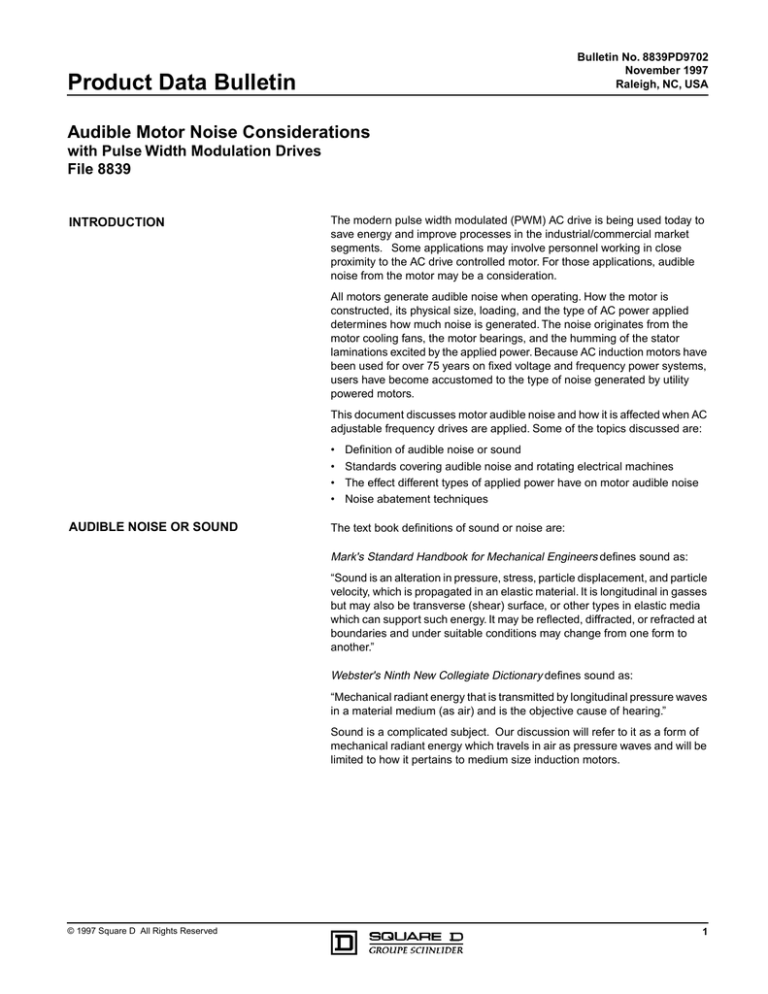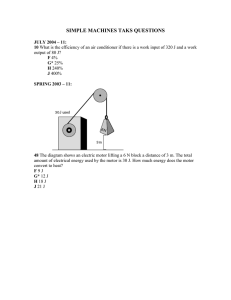
Bulletin No. 8839PD9702
November 1997
Raleigh, NC, USA
Product Data Bulletin
Audible Motor Noise Considerations
with Pulse Width Modulation Drives
File 8839
INTRODUCTION
The modern pulse width modulated (PWM) AC drive is being used today to
save energy and improve processes in the industrial/commercial market
segments. Some applications may involve personnel working in close
proximity to the AC drive controlled motor. For those applications, audible
noise from the motor may be a consideration.
All motors generate audible noise when operating. How the motor is
constructed, its physical size, loading, and the type of AC power applied
determines how much noise is generated. The noise originates from the
motor cooling fans, the motor bearings, and the humming of the stator
laminations excited by the applied power. Because AC induction motors have
been used for over 75 years on fixed voltage and frequency power systems,
users have become accustomed to the type of noise generated by utility
powered motors.
This document discusses motor audible noise and how it is affected when AC
adjustable frequency drives are applied. Some of the topics discussed are:
•
•
•
•
AUDIBLE NOISE OR SOUND
Definition of audible noise or sound
Standards covering audible noise and rotating electrical machines
The effect different types of applied power have on motor audible noise
Noise abatement techniques
The text book definitions of sound or noise are:
Mark's Standard Handbook for Mechanical Engineers defines sound as:
“Sound is an alteration in pressure, stress, particle displacement, and particle
velocity, which is propagated in an elastic material. It is longitudinal in gasses
but may also be transverse (shear) surface, or other types in elastic media
which can support such energy. It may be reflected, diffracted, or refracted at
boundaries and under suitable conditions may change from one form to
another.”
Webster's Ninth New Collegiate Dictionary defines sound as:
“Mechanical radiant energy that is transmitted by longitudinal pressure waves
in a material medium (as air) and is the objective cause of hearing.”
Sound is a complicated subject. Our discussion will refer to it as a form of
mechanical radiant energy which travels in air as pressure waves and will be
limited to how it pertains to medium size induction motors.
© 1997 Square D All Rights Reserved
1
Audible Motor Noise Considerations with PWM Drives
Product Data Bulletin
APPLICABLE STANDARDS
Bulletin No. 8839PD9702
November 1997
Sound is a form of energy which can be measured and quantified. There are
standards which aid a user in defining and measuring the sound of electric
motors. NEMA MG1-1993 Part 12.53 covers machine sound of medium
induction motors. Part 12.53.1 explains that although these standards define
the acceptable sound power level of motors, they cannot guarantee their
acceptability because sounds of the same power level can have different
sound quality.
IEEE Standard 85-1973 is a test procedure for measuring airborne sound of
rotating electrical machinery. It applies to unloaded motors mounted in
controlled environments operating at rated speed and voltage. It defines
various operating environments, the necessary measuring equipment,
possible frequency ranges of interest, and where measurements should be
made in relation to the motor. Where sound levels of loaded motors are of
interest, it recommends that the user and tester agree upon the following:
1. Mounting - Errors will be introduced into the sound measurement if the
motor vibrations cause the base or floor to vibrate.
2. Method of Loading - The connected load induces error by contributing to
the overall sound measured.
3. Background Noise - Any background noise in the frequency range of
interest contributes to the overall sound measured inducing error.
4. Accuracy of Measurements - The type of equipment used and how it is
used will yield different results for the same machine under the same
load.
5. Power Input Requirements - The referenced standards are for a motor
running with sinusoidal power at full voltage and rated speed. If other
conditions are to be measured, a complete description of those
conditions needs to be agreed upon.
6. Interpretation of Data - Both user and tester need to understand what is
being measured, how it is being measured, external influences, and the
accuracy of measurements in order to obtain useful data.
Since most users are interested in the actual operating conditions of their
facility, IEEE 85-1973 would apply only in conjunction with NEMA MG3-1974.
The NEMA MG3 standard gives users tools to estimate sound levels in
commercial and industrial environments. It leads a user through steps to
calculate the sound pressure levels workers may be exposed to after taking
measurements of individual motors per IEEE 85 and applying the proper
correction factors or adjustments.
AUDIBLE MOTOR NOISE
WITH SINE WAVE POWER
The audible noise produced by a motor originates from its stator core
laminations. The stator core is made up of thin laminated metal sheets. When
a 60 Hz sine wave voltage is applied to a motor, a magnetic flux is induced in
the stator core. This magnetic flux causes the stator to vibrate 60 times per
second producing a low pitch noise similar to that of a transformer.
AUDIBLE MOTOR NOISE
WITH PWM WAVE POWER
When a motor is powered from an adjustable frequency drive using a PWM
(Pulse Width Modulated) output waveform, the audible noise produced by the
stator laminations has a different sound quality than with sine wave power.
The adjustable frequency drive produces an output voltage waveform made
of high frequency pulses. The frequency of pulses is determined by the
carrier frequency of the selected adjustable frequency drive. The motor stator
core laminations vibrate at the carrier frequency changing the pitch of the
audible noise. Whether the actual power level of the noise is increased due
to a PWM waveform will depend upon the level of the applied excitation
voltage.
2
© 1997 Square D All Rights Reserved
Bulletin No. 8839PD9702
November 1997
NOISE ABATEMENT
TECHNIQUES
Audible Motor Noise Considerations with PWM Drives
Product Data Bulletin
There are several solutions offered in the industry today to reduce audible
motor noise when operating from a PWM adjustable frequency drive. Some
of these are:
1. Motor Location - In HVAC and pumping applications, the motor should be
located in an equipment room away from personnel. Motor location is
typically not a concern in industrial applications because of the other
ambient noise associated with the driven machinery.
2. Motor Selection - Totally enclosed non-ventilated (TENV) or totally
enclosed fan cooled (TEFC) motors will operate more quietly than open
drip proof (ODP) motors. The audible noise of TENV and TEFC motors is
more contained in the motor housing compared to the ODP motor style
construction.
3. Load Reactor - Installing a reactor on the output of the drive will reduce
the audible motor noise when low leakage reactance motors are used.
4. NOLD Circuit - Select a drive that automatically adjusts its output voltage
level to the motor load. The electrical motor audible noise will be reduced
by lowering the effective motor voltage applied. This reduces the motor
flux and resulting force on the stator laminations.
5. Random Modulated Carrier Frequency - Select a drive that randomly
modulates the carrier frequency 1 kHz above and below the center
frequency. This improves the sound quality of the motor by not allowing
the stator laminations to vibrate at a distinct pitch which the human ear
can easily detect. It also reduces the possibility of the motor mechanically
resonating at the carrier frequency which would amplify the audible noise.
6. Low Noise Drives - Select a drive rated for low noise applications. These
types of drives typically operate at a higher carrier frequency than other
drives. The higher carrier frequency reduces motor current harmonics
that contribute to stator lamination vibration and increased motor audible
noise.
Selecting the proper motor type, its location, and a low noise type adjustable
frequency drive will help reduce audible motor noise levels.
SUMMARY
© 1997 Square D All Rights Reserved
The ALTIVAR® 56 and 66 variable torque low noise (VTLN) adjustable
frequency drives by Square D offer an effective solution to audible motor
noise concerns. Their patented NOLD motor flux algorithm allows the motor
to only develop the flux it needs reducing stator lamination vibration. They use
a randomly modulated high carrier frequency output. This produces a good
sinusoidal motor current waveform low in harmonics and ensures that the
stator laminations will not vibrate at a distinct pitch. These combined features
make them a unique choice for variable torque applications where audible
motor noise is a concern.
3
Audible Motor Noise Considerations with PWM Drives
Product Data Bulletin
Bulletin No. 8839PD9702
November 1997
Square D,
Square D Company
8001 Highway 64 East
Knightdale, NC 27545
(919) 266-3671
4
, and ALTIVAR are registered trademarks of Square D Company.
Electrical equipment should be serviced only by qualified electrical maintenance personnel. No
responsibility is assumed by Square D for any consequences arising out of the use of this material.
Bulletin No. 8839PD9702 © 1997 Square D.
© 1997 Square D All Rights Reserved




